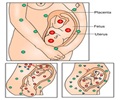Women might be at increased risk of HIV during pregnancy because of their own or their partner's sexual behaviours, or because of the physiological changes during gestation. Irrespective of the mechanism of heightened risk, findings that rates of HIV acquisition are significantly higher during pregnancy than in the postpartum period, have important implications for HIV prevention, both to protect mothers from primary HIV infection during pregnancy and to potentially avoid mother-to-child HIV transmission, which can be increased by the rise in HIV-1 viraemia associated with recent maternal infection.
In a recent study, published in the October issue of The Lancet, undertaken to address these issues, researchers assessed the incidence rate of HIV during pregnancy and lactation, and compared this to the incidence rate of HIV during periods of non-pregnancy and non-lactation using longitudinal data from a community cohort in Rakai, Uganda. It was postulated that if the incidence rate of HIV acquisition during pregnancy remained raised after adjustment for characteristics and behaviours, physiological changes of pregnancy might be responsible for any differences in incidence rates recorded during pregnancy, lactation, and non-pregnancy and non-lactation periods.Pregnant women were identified by interview and physical examination, and for women who were unsure of their pregnancy status or whose last menstrual period occurred more than a month before the survey, pregnancy status was confirmed by a urinary human chorionic gonadotropin (hCG) test. Women who were initially HIV-negative and who were neither pregnant nor breastfeeding provided a comparison group for assessment of HIV risk. Since risk of HIV in women might be associated with behaviours and HIV status of male partners, we identified husbands of married index women. HIV status was assessed by two separate enzyme immunosorbent assays with western blot confirmation of discordant enzyme immunosorbent assay results and HIV seroconverters.
The authors interpreting the results suggest that the risk of HIV acquisition rises during pregnancy. This change is unlikely to be due to sexual risk behaviours, but might be attributable to hormonal changes affecting the genital tract mucosa or immune responses. However, they admit that they cannot generalise these findings beyond the Rakai setting and it would be important for other investigators to verify them. However, if women are at increased risk of HIV acquisition during pregnancy, these findings present a public-health problem, both for the mother and possibly for her unborn infant. It would therefore be prudent for women to be aware of this potential risk of HIV acquisition during pregnancy, and to promote safe sex, or sexual abstinence where feasible.











